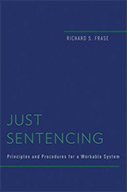Just Sentencing: Principles and Procedures for a Workable System
 Author: Richard S. Frase
Author: Richard S. Frase
Publishing: Oxford, UK; New York: Oxford University Press, 2013. 304p.
Reviewer: Richard L. Lippke | September 2013
Richard Frase’s book, Just Sentencing: Principles and Procedures for a Workable System, constitutes a formidable defense of a hybrid sentencing model, one which he terms the Expanded Limiting Retributive Model (hereafter abbreviated ELRM). Frase’s model incorporates strict upper retributive limits on sentences and less strict lower limits on them. Within those limits, other sentencing aims can be pursued, such as making sure that the costs of legal sanctions do not exceed their benefits, ensuring the expressive role of legal punishment, rehabilitating offenders, reducing racial disparities in criminal justice outcomes, and parsimony. Frase is skeptical about permitting judges to enhance sentences based on considerations of general or specific deterrence because the evidence linking sentence severity and either of these outcomes is too weak. Also, Frase is disinclined to let judges count offenders’ past records in determining their sentences, though he admits that empirically well-founded predictions of future offending, which could include aspects of prior record, might be used to modestly enhance sentences.
Frase’s book has many virtues: The writing is clear, direct, and persuasive. Frase’s grasp of the theory and practice of sentencing is exemplary. He does not shy away from difficult issues and has important and interesting things to say about them. The book is well-organized, with many quite useful summaries of the ELRM interspersed throughout the text. Anyone interested in sentencing should regard it as required reading. I suspect that Frase’s model, or something very close to it, is the most defensible approach to sentencing. My focus in this review will be on some theoretical aspects of the model that seem insufficiently explained or developed.
To begin with, I am unsure how Frase would have legislators, or the sentencing commissions that he seems to prefer, go about determining sentence ranges for offense kinds. Obviously, desert limits—strict on the upper ends but relaxed or non-existent on the lower ends—have some crucial role to play. That role could be negative, as Frase’s model suggests, or more positive. In the former case, desert considerations would serve as mostly intuitive constraints past which other considerations should not be permitted to push sentences. In the latter case, they would inform, in some more substantial way, the search for upper and lower limits, perhaps by stipulating that that the harms imposed by legal punishment should be kept commensurate with the harms culpably inflicted (or threatened or attempted) by offenders. One reason to believe that desert considerations might have to play a more substantial role in determining sentence ranges is that it is never clear how the other principles that Frase deems important in sentencing can be utilized to produce determinate sentence ranges for offense types. Chief among these other principles is the Ends/Benefit Proportionality Principle, which Frase characterizes as a “fundamental and widely adopted utilitarian principle—that the public and private costs and burdens of a criminal penalty (or of an increased penalty) should not outweigh the expected benefits (or added benefits) of that penalty.” (p. 32) In the abstract, it is hard to gainsay the notion that in thinking about offense types and the sentences suitable to them, we ought to weigh all of the costs and benefits of adopting one or another sentence range. But it seems doubtful that we have anything remotely approaching the empirical evidence we need to make informed decisions about the costs and benefits of the various candidate sentence ranges for each offense type, or the computational skills to calculate which of these ranges is optimal. As already noted, we have pretty good evidence that there is no correlation between sentence severity and general or specific deterrence. But such negative knowledge is an awful long way from more positive knowledge about the optimal sentence ranges for offense kinds. Another sentencing aim that Frase cites approvingly, the importance of having legal punishment express censure, is equally amorphous, or so it seems, in helping us to discern how much or what kinds of punishment are appropriate for the various offense types. The idea that we should censure serious crimes more than less serious ones, while undoubtedly important, is nonetheless vague when it comes to helping us decide whether, for instance, armed robbery should be punished with 1-2 years imprisonment, 3-4 years or 5-7. Further, parsimony or the reduction of racial disparities in sentencing seem most relevant to the downward reduction of sentences for offense tokens once sentence ranges have been set by other considerations.
Frase might argue that sentence ranges for offense types should be determined, in part, by assessments of the resources available for imprisonment or other kinds of sanctions. Legislators or sentencing commissions should, in his view, be prepared to adjust sentence ranges for offense types upwards or downwards in response to growth or shrinkage in jurisdictional penal budgets. Yet such an approach to determining sentence ranges seems at odds with a commitment to desert limits on legal punishment, even if only upper ones. From a deserved punishment perspective, the question is what sentence range is optimal or at least consistent with giving offenders what they deserve, not how much can we afford to spend on punishing them, whether this gives them what they deserve or not. Here we butt up against the vexed problem of cardinal proportionality in sentencing. As Andrew von Hirsch has persuasively argued, we do not need a solution to this problem that enables us to fix a determinate sentence range for every offense kind. But we do need such ranges for some offense kinds (the so-called “anchoring points” of a sentencing scheme); considerations of ordinal proportionality (to which ELRM is clearly committed) can be used to fill out the rest of the scheme. Without such anchoring points, we are left with untethered ordinal proportionality constraints. Numerous sentencing schemes, some exceedingly harsh, some exceedingly lenient, and some in-between, might all be ordinally proportional. How, then, to choose among them? Frase’s solution—to let resource availability do most of the work in solving this problem—does little to address the theoretical problem and, in fact, provides an arguably inappropriate solution to it. Moreover, as a practical matter, we might worry that his solution offers insufficient assurance that imprisonment will not be used excessively. Legislators (with the backing of voters) could simply decide to devote more resources to imprisonment and thereby facilitate the ratcheting up of punishment levels. Frase suggests that in jurisdictions in which resource issues have been taken into account by sentencing commissions, punishment levels have been kept in check. Perhaps so, but Frase’s model does not provide the conceptual or normative resources to explain why such fortuitous outcomes are ones to which desert considerations commit us.
Another feature of Frase’s model that might have been clarified concerns how powerful desert considerations are relative to the other considerations Frase deems relevant to sentencing. Desert considerations obviously trump or overrule non-desert ones in setting sentence ranges (though perhaps only at the top end). Frase believes that sanctions harsher than those deserved raise human rights issues. Fair enough, but once an offender’s crime has been located within the relevant desert-constrained sentencing range, does desert play any further role? The answer is that it does, since Frase permits judges to make upward or downward adjustments in offenders’ sentences based on aggravating or mitigating desert factors. They must, however generate a public record explaining such adjustments. Oddly, I think, Frase would have sentencing judges start in the midpoint of the relevant sentencing range and then have to justify desert-based upwards or downward departures. Why not, instead, skip the mid-range starting point and have judges locate a particular offender’s sentence in the relevant range by reference to desert factors? Still, not much turns on this. The more interesting question is this: Once a particular offender’s sentence has been presumptively set by desert considerations, how powerful must the case be for non-desert-based departures? There could be a presumption in favor of no departures, one that would be overridden only if non-desert considerations were particularly cogent. In that way, desert considerations would continue to have greater weight than other considerations in determining specific sentences, just as they do in setting sentence ranges.
Importantly, such an approach would be more likely to reduce disparities in sentencing among like offenders, a further desideratum of a defensible sentencing scheme. Frase seems more willing to permit presumptively deserved sentences to be increased or decreased by the various non-desert considerations. Not only will this require sentencing judges to weigh and balance numerous potentially conflicting factors, it will inevitably produce more disparities in sentencing among like offenders. Granted, judges might become skilled at making sentencing decisions that take into account these myriad factors, but we might wonder whether a somewhat simpler scheme, one that gives more weight to desert considerations, would be more advantageous.
One last point: The ELRM is asymmetrical in the sense that its sentence ranges have well-defined “ceilings” but not well-defined “floors.” It is wrong to punish offenders too much, but not wrong, or less wrong, it seems, to punish them too little. In particular, Frase wants to leave judges with discretion to assign offenders probation or suspended sentences, which sentences can be revoked if offenders fail to satisfy conditions stipulated at sentencing. Yet Frase’s arguments for this asymmetry are unpersuasive. He concedes that the expressive goals of sentencing, along with the need to ensure that like offenders receive at least roughly comparable sentences, might require us to impose minima of hard treatment on some offenders. However, he does not see these as desert or proportionality-based requirements. By contrast, on von Hirsch’s well-known account, that is precisely what they are: Censure must be tailored to blameworthiness and ordinal proportionality requires like offenders to be punished alike. Frase also notes how the “process costs” of arrest, investigation, and charge adjudication will impose some minimum degree of hard treatment on offenders. We might agree with him that such “penalties” are sufficient to punish many minor offenders who do not, after all, deserve much punishment. But the harder question is whether the sentence ranges for more serious offense types ought to have definite “floors.” Again, Frase suggests that disproportionately harsh sanctions raise “human rights” issues, in the sense that they seem unfair to offenders and exceed the limits of legitimate governmental power. Too little punishment does not raise such issues. But I wonder if that can be correct. Suppose that a legal regime consistently and significantly under-punishes offenses when they are committed against some or all of its citizens. If the offenses in question are grave, then this too would seem to raise human rights issues, though this time in the form of failure by the government to sufficiently protect and secure the vital interests of its citizens. Finally, Frase argues that some victims and law-abiding people do not demand minimally harsh sanctions. I doubt whether this is true if the crimes in question involve murder, rape, aggravated assault, or the theft of large amounts of property. But the deeper problem is that, by the same token, some victims or law-abiding people might demand excessively harsh sanctions, especially for certain kinds of offenses (e.g., sex crimes). Yet it seems clear that Frase does not think that we should honor such demands.
It could be argued that some kinds of crimes culpably cause so much harm to individuals or society that some substantial censure and hard treatment must be imposed upon those who commit them or else justice (in some absolute or non-comparative sense) simply will not be served. That, in turn, suggests that sentence ranges for some serious offenses should have well-defined floors.
[I am grateful to Richard Frase for many helpful comments on an earlier draft of this review.]Richard L. Lippke, Professor, Department of Criminal Justice, Indiana University.


